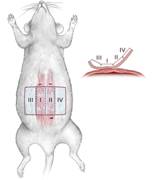Room 2 (Henry B. Gonzalez Convention Center)
Sunday, November 3, 2002
8:00 AM - 4:00 PM
Room 2 (Henry B. Gonzalez Convention Center)
Monday, November 4, 2002
8:00 AM - 4:00 PM
Room 2 (Henry B. Gonzalez Convention Center)
Tuesday, November 5, 2002
8:00 AM - 4:00 PM
Room 2 (Henry B. Gonzalez Convention Center)
Wednesday, November 6, 2002
8:00 AM - 4:00 PM
311
P10 - Basic Fibroblast Growth Factor (B-FGF) Expression and Flap Viability Following Surgical Delay of a Rat Transverse Rectus Abdominis Myocutaneous (Tram) Flap
|
Objective: To study the expression of b-FGF and flap viability in surgically delayed rat TRAM flaps. Methods: 35 female Sprague-Dawley rats were randomized to 1 of 4 groups: no delay (N=6), 7-day delay (N=12), 14-day delay (N=10), and 21-day delay (N=7). Surgical delay consisted of incising the perimeter skin of the planned TRAM flap followed by ablation of both superior epigastric arteries and the left inferior epigastric artery, thus preserving the right inferior epigastric artery, and raising all but Zone I off the abdominal wall fascia. Three days following TRAM procedure, all rats were euthanized. Post-fluoroscein planometry determined percent area viability of both superficial and deep portions of TRAM flaps. Additionally, full thickness TRAM specimens were taken from Zones I- IV for b-FGF ELISA analysis. Analysis of variance and the student T-test were used. Results: b-FGF levels (pg b-FGF/mg protein) are presented as the mean+SEM |
||||
|
Delay |
Zones |
|||
|
(Days) |
I |
II |
III |
IV |
|
0 |
41.3+16.2 |
61.3+19.4 |
27.2+11.3 |
24.1+15.0 |
|
7 |
93.2+15.1 |
88.2+15.2 |
86.1+14.5 |
94.0+15.3 |
|
14 |
93.8+10.5 |
94.5+10.4 |
75.5+5.9 |
77.5+11.1 |
|
21 |
75.9+11.2 |
66.0+8.2* |
77.3+8.7 |
79.2+11.3 |

 Background: Partial TRAM flap loss in breast reconstruction can be a devastating complication. Surgical delay of the TRAM flaps has been shown to improve its viability.
Background: Partial TRAM flap loss in breast reconstruction can be a devastating complication. Surgical delay of the TRAM flaps has been shown to improve its viability.